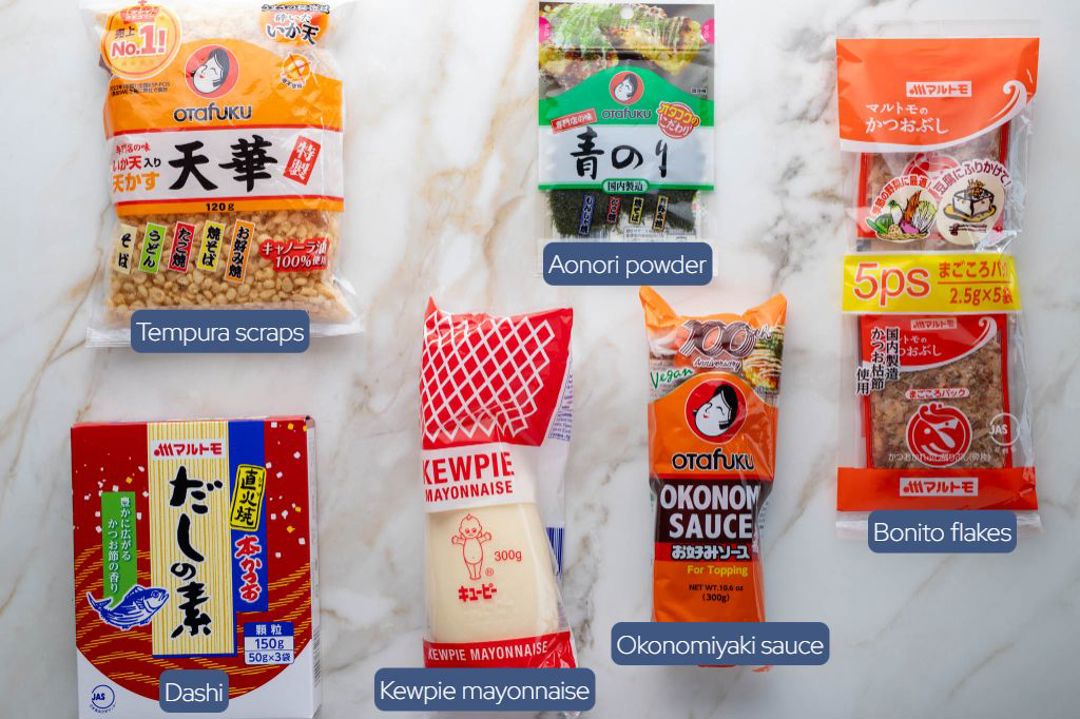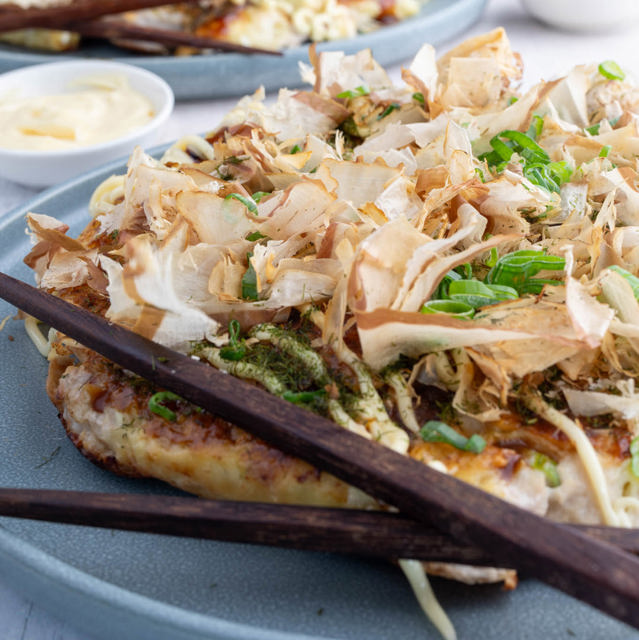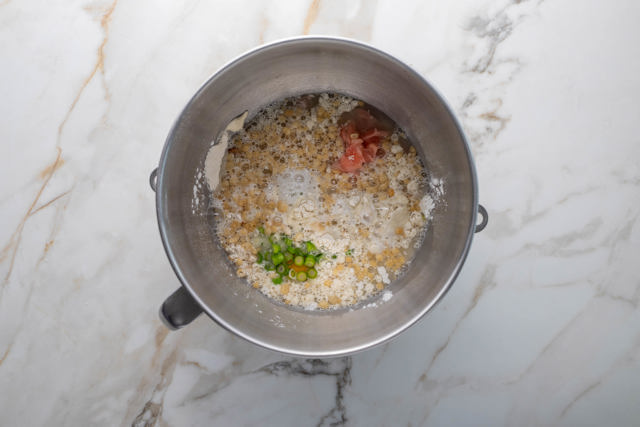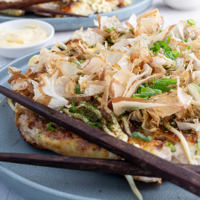Okonomiyaki is an absolutely epic savoury pancake from Japan that's packed full of flavour. Filled with cabbage and your favourite meats and vegetables, smothered with Japanese mayonnaise and a sweet and savoury sauce and topped with bonito flakes, you're missing out if you've never tried this.
There are two styles of okonomiyaki - this recipe, which is Osaka style okonomiyaki - where ingredients are all mixed together - and Hiroshima style, where ingredients are cooked separately before assembling.
Okonomiyaki literally means "what you like" (okonomi) "grilled" (yaki). As such, this is another blueprint style recipe, showing you how to make a basic and authentic Osaka style okonomiyaki. But you should add your own ingredients into the batter to put your own touch on this. For this recipe, I've used thinly sliced pork, but you could easily omit it altogether or substitute with prawns.
Okonomiyaki ingredients
- Batter made from wheat flour, baking powder, dashi (see below) and eggs.
- Thinly sliced pork - available from some supermarkets or your butcher will be able to supply you. Make sure the skin is removed, along with any excess fat.
- Green cabbage is the main filling, along with scallions - the firmer parts of the scallion go into the batter, and the thin green bits are part of the garnish.
All about the Japanese ingredients

- Okonomiyaki sauce - the most widely known brand is Otafuku. Easily found in Asian grocers and online. If you can't find the sauce, you can use your favourite barbecue sauce, a little sriracha or teriyaki sauce.
- Dashi is a Japanese stock which is made from kombu and bonito flakes, but is also readily available in a powdered form. Some larger supermarkets carry dashi powder, and it's widely available in Asian grocers. As a substitute use water and add salt to taste, or replace with vegetable or chicken stock.
- Nori - preferably for this recipe use dried green aonori flakes or powder, which you'll find at Asian grocers. As a substitute, use thinly sliced nori sheets that you'd use for sushi which are readily available at supermarkets. Feel free to leave it out if you'd prefer.
- Pickled ginger and kewpie mayonnaise are both readily available in supermarkets.
- Bonito flakes are in some larger supermarkets and in Asian grocers. It's shaved flakes of skipjack tuna which has been smoked and fermented - full of flavour. There isn't really a substitute for it, but if you don't like fish or a fishy smell, you can leave it out.
- Tempura scraps (tenkasu) - this brings a different texture and adds a rich flavour to your okonomiyaki. I had trouble finding this, even at local Asian grocers - but my research indicates it should be available at many Asian grocers. With that said, it's easy to make at home by mixing some tempura batter mix with water and drizzling into hot oil; remove with a slotted spoon and place on paper towel to absorb excess oil. Substitute for any other leftover batter. You'll still get a great okonomiyaki if you leave it out.
Equipment you need to make okonomiyaki
You need a medium sized skillet (around 10"). Your life will be made easier with a mandoline or food processor for cutting the cabbage, but you can also do it by hand - just cut it very thinly.
Step-by-Step Guide to Making Okonomiyaki
Prepare ingredients - For the cabbage, remove the core and discard any thick or damaged outer leaves. Using a knife, mandoline or food processor, thinly slice the cabbage and set aside. Slice the scallion up until it starts to turn dark green, and then chiffonade (very thinly slice) the scallion greens and set aside separately for garnishing at the end. If you're using a dashi powder, make the dashi following the packet instructions.
Make batter - add the flour, dashi, cornflour/cornstarch, baking powder and eggs to a large bowl (1) and whisk well to combine (2). Ensure there are no lumps and that everything is well combined.
Add fillings - to your batter, add the green cabbage, the bottom part of the scallions (reserving the tops for later), pickled ginger and tempura scraps. Use your hand, spoon or spatula to combine.
Cook - add the oil to a medium (10") non-stick skillet and heat over medium heat. When the pan is warm, add a 1.5 tsp of oil, half the pork slices (1) and half the batter mixture (2) to the pan and gently spread it around. Keep an eye on the heat, you want to slowly brown the bottom of the okonomiyaki while it mostly cooks through, which will take about 10 minutes.
Flip - When the okonomiyaki is starting to look cooked around the sides, flip it. The easiest way is to loosen the edges with a spatula, place a large plate over the skillet, and invert it so the okonomiyaki falls onto the plate, uncooked side down. Return the pan to the heat, add another 1.5 tsp of oil, and slide the okonomiyaki back in, uncooked side down. Cook until browned and cooked through, about 5 more minutes.
Finish - when the okonomiyaki is cooked through, remove from the pan and place on a chopping board or plate. Top with the okonomiyaki sauce, kewpie mayonnaise (1), bonito flakes, aonori powder/flakes and reserved scallions (2).
Cook remaining batter by repeating steps 4 through 6.
Serve - slice the okonomiyaki and serve.
Tips
- Watch your temperature so that you don't burn the okonomiyaki before it's cooked through. I cook on 5/10 which works well for me.
- Mix the batter well so that there are no lumps in it.
- Be careful when flipping the okonomiyaki that it doesn't break; easiest way to do it is to place a plate on top of the okonomiyaki, invert the pan while holding the plate to catch it, and then slide the wet side off the plate down into the pan.
- Go generous with the toppings; the sauce, mayonnaise, seaweed flakes and bonito flakes should be plentiful.
- For the best result, thinly slice the cabbage using a mandoline or food processor with a slicing attachment.
- If you're using seafood instead of pork, add it to the top of the batter just before flipping to prevent overcooking.
What to serve with okonomiyaki
- Yakitori, which are grilled skewers.
- Karaage fried chicken
- Fried potatoes with shichimi and red miso mayo
Hiroshima vs Osaka style okonomiyaki
Hiroshima-style Okonomiyaki uses many of the same ingredients as Osaka-style okonomiyaki, but usually has the addition of noodles. The primary difference is how the ingredients are prepared; for the Hiroshima-style okonomiyaki the ingredients are cooked separately and then combined into a stack.
Make ahead, reheating and freezing okonomiyaki
Okonomiyaki can be made ahead a few days before you want to eat - it will keep in the fridge for 3-4 days if made with pork (or without any added protein). If you use seafood, I'd give it a day, maybe two if the seafood was really fresh - seafood breaks down much quicker. Keep the cooked pancake in the fridge without toppings (bonito, nori, sauce and mayo) and reheat in the microwave or in a pan over low heat until warm.
If you want to freeze okonomiyaki, do so without adding the toppings - it freezes well and will last 2-3 months in a sealed bag. Defrost in the fridge a day before you want to eat and reheat in a microwave or in a pan over low heat until warm.
Add your own touch
- Change ingredients as you see fit - the whole point of the dish is to be "what you like, grilled", some examples are below.
- Proteins - try different types or combinations; chicken, prawns/shrimp, squid or tofu.
- Vegetables - peas, corn, grated carrots, finely diced capsicum/bell peppers.
- Other fillings - try herbs like parsley, chives or coriander/cilantro. Try spices like curry powder or chilli flakes. Add some cheese for a melty texture.
- Sauce - change the okonomiyaki sauce to your favourite barbecue sauce, sriracha or teriyaki sauce. Mix a little wasabi with the mayonnaise.
Authenticity note
Authentic Osaka style okonomiyaki should be made with a grated Japanese yam, nagaimo. While shelf stable Japanese ingredients can be found in the west, fresh ingredients can be challenging; for this reason I chose to omit it from my recipe and use baking powder instead. The function of the yam is to prevent the batter from being overly doughy and to make it fluffy.
If you are able to find the yam, you can omit the baking powder and use the yam. My research indicates that 100-150g of grated yam will be sufficient; add it before whisking the batter.

Okonomiyaki (Osaka-style)
| Prep | Cook | Total |
|---|---|---|
| 10 mins | 30 mins | 40 mins |
- 700g green cabbage about half a large cabbage
- 3 scallions
- 225g (1 1/2 cups) flour
- 375ml (1 1/2 cups) dashi see note 1
- 2 tbsp cornflour/cornstarch
- 1 tsp baking powder
- 2 eggs
- 2 tbsp pickled ginger optional - see note 2
- Handful of tempura batter scraps optional - also known as tenkasu, see note 3
- Neutral oil, divided about 2 tbsp
- 400g thinly sliced pork no skin, see note 4 for recommendations and substitutions
- Bonito flakes see note 5
- Okonomiyaki sauce or your favourite BBQ sauce, see note 6
- Kewpie mayonnaise or another Japanese mayonnaise
- Aonori powder or flakes or thinly slice nori sheets, see note 7
- Prepare ingredients - For the cabbage, remove the core and discard any thick or damaged outer leaves. Using a knife, mandoline or food processor, thinly slice the cabbage and set aside. Slice the scallion up until it starts to turn dark green, and then chiffonade (very thinly slice) the scallion greens and set aside separately for garnishing at the end. If you're using a dashi powder, make the dashi following the packet instructions.
- Make batter - add the flour, dashi, cornflour/cornstarch, baking powder and eggs to a large bowl and whisk well to combine. Ensure there are no lumps and that everything is well combined.
- Add fillings - to your batter, add the green cabbage, the bottom part of the scallions (reserving the tops for later), pickled ginger and tempura scraps. Use your hand, spoon or spatula to combine.
- Cook - add the oil to a medium (10") non-stick skillet and heat over medium heat. When the pan is warm, add a 1.5 tsp of oil, half the pork slices and half the batter mixture to the pan and gently spread it around. Keep an eye on the heat, you want to slowly brown the bottom of the okonomiyaki while it mostly cooks through, which will take about 10 minutes.
- Flip - When the okonomiyaki is starting to look cooked around the sides, flip it. The easiest way is to loosen the edges with a spatula, place a large plate over the skillet, and invert it so the okonomiyaki falls onto the plate, uncooked side down. Return the pan to the heat, add another 1.5 tsp of oil, and slide the okonomiyaki back in, uncooked side down. Cook until browned and cooked through, about 5 more minutes.
- Finish - when the okonomiyaki is cooked through, remove from the pan and place on a chopping board or plate. Top with the okonomiyaki sauce, kewpie mayonnaise, bonito flakes, aonori powder/flakes and reserved scallions.
- Cook remaining batter by repeating steps 4 through 6.
- Serve - slice the okonomiyaki and serve.
- Dashi is a Japanese stock which is made from kombu and bonito flakes, but is also readily available in a powdered form. Some larger supermarkets carry dashi powder, and it's widely available in Asian grocers. As a substitute use water and add salt to taste, or replace with vegetable or chicken stock.
- Pickled ginger - readily available in the Asian section of most grocery stores. Leave it out if you prefer.
- Tempura scraps (tenkasu) - this brings a different texture and adds a rich flavour to your okonomiyaki. I had trouble finding this, even at local Asian grocers - but my research indicates it should be available at many Asian grocers. With that said, it's easy to make at home by mixing some tempura batter mix with water and drizzling into hot oil; remove with a slotted spoon and place on paper towel to absorb excess oil. Substitute for any other leftover batter, or leave it out if you prefer.
- Pork & other proteins - I use thinly sliced lean pork here which is commonly used in Japan. Whichever cut you choose to use, remove the skin because it will make it difficult to eat; if you want to substitute it for another protein you can - see the post for giving okonomiyaki your own touch. You can also leave the protein out if you'd prefer.
- Bonito flakes are in some larger supermarkets and in Asian grocers. It's flakes of skipjack tuna which has been smoked and fermented - it's full of flavour. There isn't really a substitute for it, but if you don't like fish or a fishy smell, you can leave it out.
- Okonomiyaki sauce - the most widely known brand is Otafuku. Easily found in Asian grocers and online. If you can't find the sauce, you can use your favourite barbecue sauce, a little sriracha or teriyaki sauce.
- Aonori powder/flakes - preferably for this recipe use dried green aonori flakes or powder, which you'll find at Asian grocers. As a substitute, use thinly sliced nori sheets that you'd use for sushi which are readily available at supermarkets. Leave out if you'd prefer.
- Skillet size - I suggest making this in a 10" skillet because it will be significantly easier to flip, and it's the perfect amount for 2x 10" okonomiyaki pancakes.
- Temperature - don't go too high, I use 6/10 - you want to slowly brown the okonomiyaki over about 10 minutes while it cooks through.




























